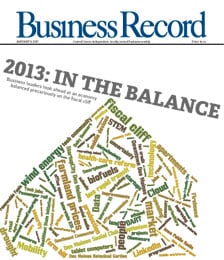DNAtoday seeks acceptance of DNA-based passport standard

Though they might make great keepsakes of one’s international travels, paper passports need some serious updating to improve countries’ border security, says Steven Whitehead
As president of DNAtoday LLC, a West Des Moines-based maker of DNA “smart cards,” Whitehead hopes to make his product the standard identification tool used at national entry stations worldwide. Rather than applying an ink stamp to paper, officials would electronically “stamp” a credit-card-sized smart card, which would carry a unique number based on the person’s genetic makeup on a computer chip.
“It’s an idea that’s just starting to gain some momentum,” said Whitehead, who said he informally broached the concept with customs officials during a recent trade show in Washington, D.C.
“They encouraged us moving forward with the idea,” he said. “We didn’t have one person say, ‘It’s not a very good idea; you’d better give up on that.’”
The use of DNA-based numbers as a unique identifier on passports would eventually allow customs officials to verify a person’s identity on the spot with 100 percent accuracy, Whitehead said. However, until the testing technology becomes faster — it currently takes up to 24 hours to get the results of a DNA sample taken from inside a person’s mouth — for now the system would augment other identification technologies, such as iris or fingerprint scans, he said. Other personal identification data, including a photo, fingerprints or other biometric data, could also be stored on the card.
The 2-year-old company, whose products include an online child identification card registration program as well as identification card programs for Native American tribes, hopes to be the first to employ DNA technology in the international security market.
In addition to funds received from private investors, DNAtoday last year received a $100,000 Entrepreneurial Ventures Assistance award from the Iowa Department of Economic Development, agreeing to repay the loan from royalties it earns on its products. Whitehead said he’s hopeful the company will turn a profit in the coming quarter based on contracts that are pending for its tribal ID/registration program.
In January, Whitehead unveiled his smart-card passport concept at an international forum in Dubai in the United Arab Emirates. This month, he will present his ideas at a forum in Singapore, and in May, he will speak at a workshop during the World Customs Exhibition and Forum to be held in Baku, Azerbaijan, hosted by the World Customs Organization.
“What we’re trying to do is form a multinational steering committee to move this forward on an international basis,” he said.
Thomas Tass, executive director of Borderpol, a non-profit border security advocacy organization based in Budapest, Hungary, said DNA Today “has a very compelling argument for using their technology in conjunction with a smart card to streamline the system.”
Any standard that’s adopted must be sufficiently easy to use so it will facilitate the movement of legitimate traffic in and out of borders, said Tass, who met Whitehead during the Dubai conference. Gaining acceptance of a new system and guiding it to the implementation stage will likely take three to five years, he said.
“It will take patience and perseverence, particularly from the political perspective,” he said.
Though other biometric measures, among them facial recognition, iris scans and fingerprint scans, have been proved to be highly effective through test programs, one based on DNA holds the promise for the best long-term identification tool, Whitehead said.
The biggest drawback, which Whitehead believes will be resolved as technology advances, is the time required to complete a DNA test to verify the information on a card. Currently, it can take as long as 16 to 24 hours to get the results back from such tests.
“It’s a good, infallable secondary measurement, and we’re looking for the time it becomes instantaneous,” he said.
Several ID approaches being considered
For the past several years following the Sept. 11, 2001, terrorist attacks, efforts have been under way to develop biometric-based identification cards, both to speed travelers through airport security checkpoints and to process people more quickly through customs checkpoints.
Britain and Japan were among the first countries to test biometric passports to determine whether facial recognition, iris scans or inkless digital finger scans provided the best identifying information to be embedded on smart-card chips for officials to scan.
In June 2004, the U.S. Transportation Security Administration rolled out a test program for its Registered Traveler program at five major airports — Minneapolis-St. Paul International, Los Angeles International, George Bush Intercontinental in Houston, Boston’s Logan International and Reagan Washington National. Under the program, approximately 10,000 U.S. travelers have voluntarily registered their personal information with the TSA, in return for an ID card that allows them expedited screening after being positively identified through either an iris scan or digital finger scan.
“We actually have extended that program through Sept. 30 at the five pilot sites,” said Amy Von Walter, a TSA spokeswoman in Washington, D.C.
In addition, the TSA recently entered into an agreement with the Orlando Airport Authority for a public-private demonstration project at the Orlando International Airport. Companies will bid to administer the smart-card program at the airport under TSA guidelines.
“It’s a way for us to partner with the private sector to determine how to structure the program moving forward,” Von Walter said. “We’ve certainly seen success in the pilot sites, but we want to see whether the public-private model would be effective.”
A similar program for frequent travelers is now being tested with travelers at New York’s John F. Kennedy International Airport and Schiphol Airport in Amsterdam. Long-range plans, according to a Department of Homeland Security release, are to issue machine-readable U.S. passports that will use facial recognition as the primary identification tool.






